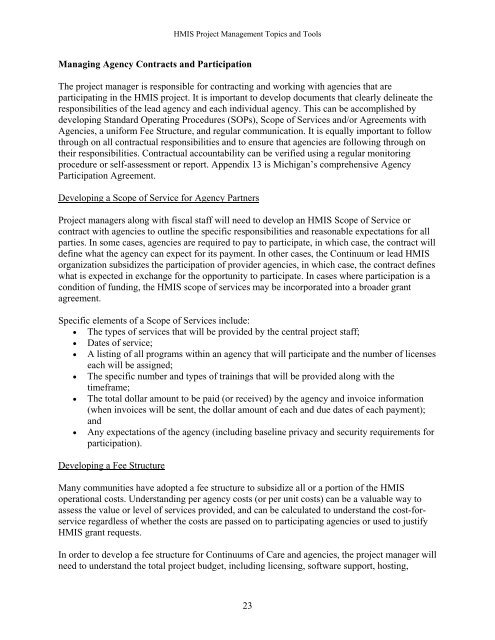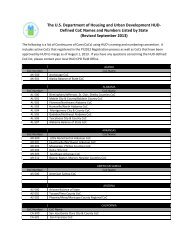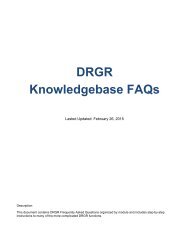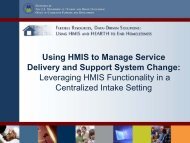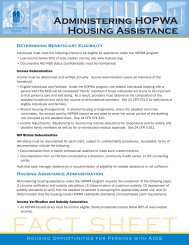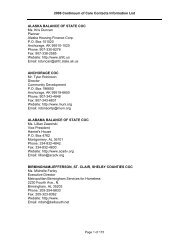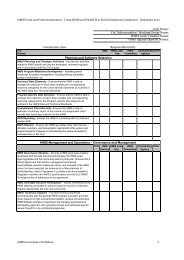HMIS Project Management Topics and Tools - OneCPD
HMIS Project Management Topics and Tools - OneCPD
HMIS Project Management Topics and Tools - OneCPD
- No tags were found...
You also want an ePaper? Increase the reach of your titles
YUMPU automatically turns print PDFs into web optimized ePapers that Google loves.
<strong>HMIS</strong> <strong>Project</strong> <strong>Management</strong> <strong>Topics</strong> <strong>and</strong> <strong>Tools</strong>Managing Agency Contracts <strong>and</strong> ParticipationThe project manager is responsible for contracting <strong>and</strong> working with agencies that areparticipating in the <strong>HMIS</strong> project. It is important to develop documents that clearly delineate theresponsibilities of the lead agency <strong>and</strong> each individual agency. This can be accomplished bydeveloping St<strong>and</strong>ard Operating Procedures (SOPs), Scope of Services <strong>and</strong>/or Agreements withAgencies, a uniform Fee Structure, <strong>and</strong> regular communication. It is equally important to followthrough on all contractual responsibilities <strong>and</strong> to ensure that agencies are following through ontheir responsibilities. Contractual accountability can be verified using a regular monitoringprocedure or self-assessment or report. Appendix 13 is Michigan’s comprehensive AgencyParticipation Agreement.Developing a Scope of Service for Agency Partners<strong>Project</strong> managers along with fiscal staff will need to develop an <strong>HMIS</strong> Scope of Service orcontract with agencies to outline the specific responsibilities <strong>and</strong> reasonable expectations for allparties. In some cases, agencies are required to pay to participate, in which case, the contract willdefine what the agency can expect for its payment. In other cases, the Continuum or lead <strong>HMIS</strong>organization subsidizes the participation of provider agencies, in which case, the contract defineswhat is expected in exchange for the opportunity to participate. In cases where participation is acondition of funding, the <strong>HMIS</strong> scope of services may be incorporated into a broader grantagreement.Specific elements of a Scope of Services include:• The types of services that will be provided by the central project staff;• Dates of service;• A listing of all programs within an agency that will participate <strong>and</strong> the number of licenseseach will be assigned;• The specific number <strong>and</strong> types of trainings that will be provided along with thetimeframe;• The total dollar amount to be paid (or received) by the agency <strong>and</strong> invoice information(when invoices will be sent, the dollar amount of each <strong>and</strong> due dates of each payment);<strong>and</strong>• Any expectations of the agency (including baseline privacy <strong>and</strong> security requirements forparticipation).Developing a Fee StructureMany communities have adopted a fee structure to subsidize all or a portion of the <strong>HMIS</strong>operational costs. Underst<strong>and</strong>ing per agency costs (or per unit costs) can be a valuable way toassess the value or level of services provided, <strong>and</strong> can be calculated to underst<strong>and</strong> the cost-forserviceregardless of whether the costs are passed on to participating agencies or used to justify<strong>HMIS</strong> grant requests.In order to develop a fee structure for Continuums of Care <strong>and</strong> agencies, the project manager willneed to underst<strong>and</strong> the total project budget, including licensing, software support, hosting,23


